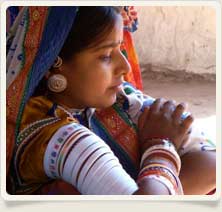Categories & Interest
Luxury Trains of India
Rajasthan Travel Guide
Travel Utilities

'India is a land of diversities'. This fact is all the more pronounced in Rajasthan. The Desert Land is dotted by Simple People, Bright Attires, Impressive Turbans and A Linage Of Graceful Women !
According to the 2001 census, Rajasthan has a total population of 56.5 million.
Unlike the olden days, the profession of the people no more decides their caste. The people are free to opt for any profession. People of different castes and sub-castes co-exist in Rajasthan. Rajasthanis are sturdy and simple. They are unaware of the fast pace that the modern life moves on. This makes Rajasthan one amongst the safest destinations worldwide.
Colourful and Ornamental
Colourful attires dominate the land. The bright costumes and attires of the Rajasthanis present a complete contrast to the barren, colourless landscape and the monotony of its cloudless sky. Irrespective of the caste, each person has a distinct preference for bright costumes. Whether a rural folk or a Raja, attires in bright red, brilliant yellow or lively green are preferred by one and all. A sparkling gold or silver zari highlight lends the perfect finish.
Rajasthani women love to wear jewelery in silver. The age-old designs characteristic of a specific tribe, reflect in the ornaments. Normal ornaments of neck, nose, ear and hand are worn by Rajasthani women on daily basis, but on special occasions and social gatherings several additional ornaments are worn to look even more beautiful. Exquisite designs of the jewelery and ornaments of Rajasthan has made them popular not only amongst the women of India but also amongst the women of the foreign countries.
Impressive Turbans
Turbans, popularly known as pagdi, vary with varying religion and region. The Rajput turbans are completely different from the Sikh and the Arab turbans.
Not only cuisine, water and dialect but turbans also change within every 12 miles in Rajasthan. As a matter of fact, there are almost 1,000 different styles of wearing turbans. Each style of the turban highlights the region, caste and class of the individual. Brightly coloured turbans are preferred by the residents. Special turbans are worn on special occasions.
A Lineage of Graceful Women
The womenfolk of Rajasthan are identified for their beauty and grace. Maharani Padmini Devi of Chittaurgarh is the perfect example of a beauteous beauty of Rajasthan. Yet another beauty, Maharani Gayatri Devi, the present day 'Rajmata of Jaipur', was listed amongst the ten most beautiful women in the whole world. Her charm has not diminished till date...

Rajasthan tribals were the original inhabitants of the area now called Rajasthan. Every tribe, small or big, shares common traits.
Rajasthan tribals form approximately twelve percent of the total population of Rajasthan. In fact, they were the original inhabitants of the area presently called Rajasthan. The Bhils and the Minas are the principal tribes of Rajasthan, India. Amongst the smaller tribes are Sahariyas, Gaduliya Lohars and the Garasias.
The common traits shared by the different tribes of Rajasthan link their past together. Each tribe is distinguished by difference in their costumes, festivals and ornaments.
Some of the main tribes of Rajasthan are:
Bhils
Bhils, the principal tribe of Rajasthan, comprise approximately 39% of the total tribal population in Rajasthan. Banswara area is dominated by this tribal group. They were believed to be fine archers and some Bhil bowmen found a mention in the Ramayana and the Mahabharata. In order to maintain their number, the Bhils mingled with the Rajputs.
A number of Bhils gather at the Baneshwar festival held in Dungarpur. They rejoice by singing and dancing at the festival. Yet another festive time for Bhils is Holi. Superstition is deep rooted in the Bhil culture.
Minas
Minas, the second largest tribe in Rajasthan, dominate the area of Shekhawati and other eastern parts of Rajasthan. They originally resided at the Indus Valley civilization.
Minas have tall and athletic built and sharp features including large eyes, light brown complexion and thick lips. Alike the Bhils, the literacy rate amongst the Minas is low. They are married in quite young years.
Gadiya Lohars
Originally a martial tribe, Gadiya Lohars derived their name from the attractive bullock carts popularly called gadis. Nowadays, they are nomadic blacksmiths. They left their homeland after Maharana Pratap was ousted from Chittorgarh by Emperor Akbar.
Garasias
Garasias, small Rajput tribe resides along the Abu Road area in southern Rajasthan. Marriage through elopement is an interesting custom followed by this tribal group.
Sahariyas
Sahariyas, the jungle dwellers, are found in Kota, Dungarpur and Sawai Madhopur areas o southern Rajasthan. Thought to be of Bhil origin, they are considered the most backward tribe in Rajasthan. Hunting and fishing are the main sources of earning a livelihood.
Damors
Damors, chiefly, cultivators and manual laborers migrated from Gujarat to Rajasthan and settled in the Udaipur and Dungarpur districts.
Other tribes of Rajasthan include:
Ask our Travel Experts!